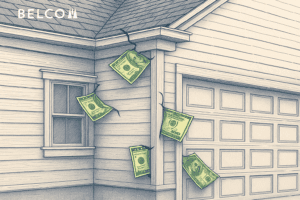Exterior trim is one of the most important finishing pieces of the design when siding your home. When you’re planning the trim and determining its color, placement, and impact on the rest of the facade, it’s also important not to overlook the fascia board, and the impact it can have on your design.
Fascia boards may play a small role in the overall appearance of a home, but it’s still important to the function and the style of the finished exterior. Make sure to understand everything there is to know about fascia boards, so you can use it more effectively on your exterior designs.
What Are Fascia Boards on a house?
Fascia is a specific type of trim, which is installed just below the roof line. It helps to cover the soffit, and provides a more finished appearance for the roof and eaves of the home. These boards may vary in width, but is generally a slightly wider or thicker version of the same trim used on the rest of the home. It’s normally painted the same color or given the same finish as the other trim, so that the home can have a more cohesive design or appearance.
What Do Fascia Boards Do?
Besides its appearance, fascia board actually has a practical function supporting the roofline of the home. Fascia boards are made from structurally strong wood, which helps give support to the gutter, as well as to the soffit, which is installed just behind it. The fascia supports these sections of the home, and gives the gutter and gutter tiles something to attach onto. It also gives the roof sheathing and the roof flashing something to adhere to while giving the area a weather tight seal.
The fascia board needs strength to carry the weight of not only the soffit. But also needs to be able to support the weight of the gutters when they’re filled with rain. That is why this trim is generally a little larger or thicker than the trim used elsewhere on the home. And why it’s so important to choose a fascia board material that is strong, and durable. Being sure to hold up well over time no matter what the climate or elements it’s exposed to.
Just below the roofline is where the drip edge boards are installed. The drip edge board serves the purpose of preventing moisture traveling from the edge of the roofing material under the fascia boards causing conditions for rot to occur. The drip edge trim moves rain water from the roof edges to the face of the drip edge material and onto the face of the fascia.
More To Consider When Choosing Fascia Boards
Like many siding and trim products, fascia boards can be made from several different materials with different textures. In many instances, it will be matched to the soffit and trim used elsewhere on the home. So if these materials are made of wood, the fascia board should be also, to help give the most cohesive appearance to the property.
Unlike the rest of the trim on the home, fascia boards will also bear a great deal of weight. For this reason, it’s important to choose a material for the trim and fascia boards that are strong, durable, low maintenance, and able to withstand the climate.
What Are Fascia Boards Made From?
Cedar and other woods typically used for trim often don’t hold up well when used as trim especially without underlying wood fiber protection. Constant heat, cold, and UV exposure, causing paint finishes to breakdown, bubble, peel, and crack exposing the wood beneath. The wood will then absorb rain and snow water, leading to fungal growth and eventual rot, which in turn means that the appearance is impacted.
Vinyl and PVC trim has become a popular alternative to wood. This material isn’t impacted by moisture or a peeled or cracked finish. However, any type of plastic fascia board will have issues. That means it can fail even more quickly than cedar or other types of wood. Vinyl and plastic fascia boards will soften in the heat. The weight of the weight of water filled gutters will cause the fascia to warp. Very cold climates can cause the material to become brittle. Which means fascia to crack, and the ultimate failure of the area.
One good alternative to these materials is to use preservative-treated wood as the fascia board and trim. Preservative-treated and primed Belco XT® Trim products help resist issues that lead to wood rot. This preservative treated and primed wood fascia trim can stay protected and looking its best for greater lengths of time. Longer lasting than other products with just a primer coat added to bare wood that resists moisture with no underlying wood fiber protection.
What is the best material for Fascia Boards?
The best material for fascia boards depends on various factors such as climate, budget, and aesthetic preferences. Common materials include wood, vinyl, aluminum, and composite. Wood is traditional and offers a classic look, while vinyl and aluminum are more durable and low-maintenance. Composite fascia boards combine wood fibers and plastic, providing a balance of durability and aesthetics.
The best material for fascia boards depends on various factors such as climate, budget, and aesthetic preferences. Common materials include wood, vinyl, aluminum, and composite. Wood is traditional and offers a classic look, while vinyl and aluminum are more durable and low-maintenance. Composite fascia boards combine wood fibers and plastic, providing a balance of durability and aesthetics.
The primed surface ensures that the fascia trim is ready for painting, allowing for a customized finish that can complement any home exterior. This combination of treatments enhances the lifespan and performance of wood fascia boards, making them a reliable and attractive option.
What size are fascia boards?
A typical fascia board size ranges between:
1×6 inches: This is a common size for residential homes and is often used for aesthetic and functional purposes. Others common sizes include:
- 1×8 inches: Provides a slightly larger surface area, suitable for homes with more substantial roof overhangs.
- 2×6 inches: Used for additional strength and durability, particularly in areas with heavy snowfall or wind.
- 2×8 inches: Offers even more support and is suitable for larger structures or areas needing more robust fascia boards.
These sizes can be customized based on specific architectural needs and preferences.
5 Fascia Trim Design Ideas
Fascia trim isn’t just functional; it can also be an important part of the home’s finished design when painted. The following design ideas can help you visualize how exterior fascia trim can play an important role in the finished style.
1. Decorative Fascia Trim
Decorative fascia trim in this example is layered to help create more depth for the front area of the home. This type of design also helps strengthen the area helping it last longer.
2. Clean White Trim
This fascia board completely frames out the roof overhang of this small front porch. At the transition point between the overhang and the posts the roofline, the fascia brings more attention to the area.
3. Dark Contrast
This home features a red tile roof with a white stucco siding. The dark-colored fascia trim helps to create a bridge between those two colors and helps unify the areas. While also highlighting the various rooflines, calling more attention to them.
4. Subtle Fascia
Not every fascia board trim needs to be oversized or to stand out. This subtle roof fascia trim helps make the transition to the soffit. But doesn’t call any additional attention to the area.
5. Roofline Accent
This home has a few different roof peaks, which are accented with different colors of siding. The substantial fascia trim helps to call more attention to the trim areas. Helping them stand out and get more attention in the design.
Make the Most of Your Fascia Board Trim
Fascia boards are important to both the looks and the function of the home. Make sure that you’re using the right type of fascia board to help your home look its best. Contact Belco Forest Products to speak with an expert on fascia boards today.












